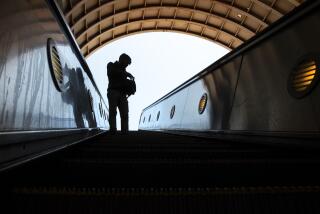New concerns arise over body scanners
Reporting from Washington — As the government begins deploying whole-body imaging machines to replace metal detectors at airports nationwide, some security experts worry that the new technology could make it easier, not harder, to sneak weapons and explosives onto airplanes.
In the wake of the attempted Christmas Day airline bombing, the Transportation Security Administration decided to double its investment in the new machines, with a goal of installing 450 across the country by the end of the year and 1,800 by 2014.
The machines are best-known for the privacy issues they pose, because they can peer through clothes and present screeners with an image that some have likened to a virtual strip search. The government has addressed those concerns by obscuring the faces of those being screened, preventing examiners from seeing the passengers, and allowing the option of a physical pat down.
But the TSA has not been able to ease concerns among some aviation security specialists about the body imagers.
“I can overcome the body scanners with enough explosives to bring down a Boeing 747,” said Rafi Sela, former chief security officer at the Israel Airport Authority, who is now a security consultant.
The TSA won’t talk about specific capabilities but says the body imagers will better enable screeners to find nonmetallic weapons, including concealed powdered and liquid explosives that do not set off metal detectors.
“No technology is going to be the silver bullet, but this is a significant enhancement,” said Robin Kane, assistant administrator for the TSA’s Office of Security Technology.
Officials hastened deployment of the scanners after Nigerian Umar Farouk Abdulmutallab allegedly smuggled a powdered explosive sewn in his underwear onto a Detroit-bound flight from Amsterdam last Christmas, but failed to detonate it.
However, Stephen M. Lord of the Government Accountability Office told Congress in March that the TSA’s classified testing shows it’s unclear whether the technology would have detected Abdulmutallab’s bomb.
The GAO also noted that unlike metal detectors, the body imagers rely on TSA employees to accurately read the image, as they must do with X-ray images of carry-on bags.
Classified tests show that X-ray screeners routinely miss threats, said Clark Ervin, former Department of Homeland Security inspector general. The rate of detection for baggage X-rays is “disastrously low, and it’s no better than it was on 9/11 — that’s the scary thing,” he said.
Two of the $170,000 body imaging machines are in place at Los Angeles International Airport, 19 at Chicago’s O’Hare, and four at Baltimore Washington International Airport, the TSA says. The extra staff needed to operate them eventually will cost several billion dollars, the GAO says.
The technology, although effective against certain threats, is too easily beatable, said several aviation security experts, some with ties to competing products.
“I think it is a mistake to use this as a primary screening tool,” said Rich Roth, a former Secret Service official now with Maryland-based CTI Consulting. “The things it can miss are more likely to be used as a weapon than the things it can catch.”
Art Kosatka, chief executive of Transecure, a Leesburg, Va., airport security consulting firm, said the machines will not detect material concealed in the groin and in body cavities. “You can get metallic items by that screening technology that you can’t get by metal detectors,” said Douglas Laird, former head of security for Northwest Airlines.
Many security experts have a financial stake in the debate: Laird is now a consultant whose clients include CEIA, a metal-detector maker; and Sela consults for clients that market different security measures.
A consulting firm run by Michael Chertoff, the former Homeland Security secretary and an advocate for the imagers, has represented vendors trying to market the technology, though it no longer does, said J. Bennet Waters, a firm member and former TSA official.
Kane, who spent 20 years in the Coast Guard before joining the TSA in 2005, says the imagers have “met our requirements,” and can detect small items hidden on the body.
In a testing center at Washington’s Reagan National Airport, he showed a reporter photos of small items that had been detected on passengers, including a one-inch-square packet of cocaine.
“Not all of these were in easy-to-find places — they were artfully concealed to get past security,” he said.
The critics don’t dispute that the imaging technology is superior to metal detectors at finding hidden nonmetallic objects. But some say it should be used only in conjunction with metal detectors and other technologies.
“Every machine can be beaten to one degree or another,” said John Huey, who in a widely circulated blog post blasted the TSA’s decision to deploy imagers. “What you need is layers of machines.” Huey has a patent for such a multitiered security system.
More to Read
Sign up for Essential California
The most important California stories and recommendations in your inbox every morning.
You may occasionally receive promotional content from the Los Angeles Times.











